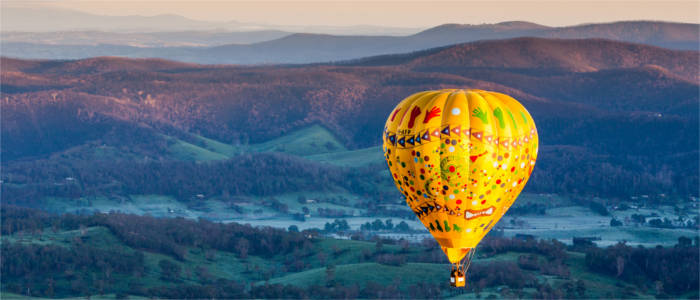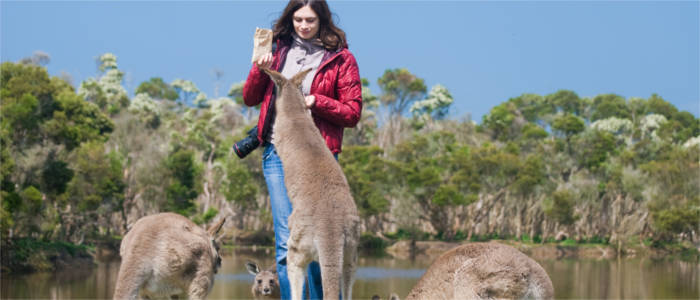Travel Offers
Travelmyne Featureprint
Distance
Victoria - A Magical Coastal Landscape
Travellers see scenic shorelines, stunning beaches, impressive cliff coasts and unique rock formations such as the Twelve Apostles on their tour through Victoria. In addition, historical gold mining sites and the cultural metropolis of Melbourne are important parts of the region.

Geography - The smallest state on the Australian mainland
Victoria is a state in the south-east of Australia with the cultural metropolis of Melbourne as its capital. Although Victoria is the smallest state on the Australian mainland with an area of 227,42 km², it has the second highest population (5.8 million) as well as the country's second highest population density (after the Australian Capital Territory). The region's most important river is the Murray River, which runs along the border of New South Wales. Victoria's highest peak is Mount Bogong in the Australian Alps with a height of 1,986 metres. The climate is partly maritime, partly temperate. Victoria has the second highest amount of precipitation in Australia after Tasmania but precipitation decreases considerably towards the north.

Nature - The Great Ocean Road and the southernmost point on the Australian mainland
Victoria is most of all known for its wonderful church and the Great Ocean Road. The road, which is 250 kilometres long, runs along magical landscapes with cliff coasts, sandy beaches as well as small bays and caves. One of the best-known rock formations and frequently photographed landforms are the Twelve Apostles. The mountains of the Australian Alps, the Gippsland Lakes, the Murray River and Phillip Island are also part of Victoria. The latter is about 120 kilometres, located south of Melbourne and one of the most popular destinations in the country because of the penguin parades at Summerland Beach in the evening. Travellers can watch seals at close range on the Seal Rock and see koala bears in the Koala Conservation Centre. Real natural highlights are the red sandstone mountains in the Grampian National Park and the peninsula of the Wilson Promontory. The Wilson Promontory National Park and the peninsula of the same name constitute the southernmost point of the Australian mainland and are an extraordinary retreat with their white sandy beaches, barren cliffs, beautiful mountains as well as thick rainforests and light-flooded eucalyptus forests.

Culture - Australia's cultural capital and historical gold mining sites
The state of Victoria owes its name to the British Queen Victoria (1819-1901). In the 1830s, the territory was first settled by Europeans. The present-day metropolis of Melbourne, which is now Australia's cultural centre, was founded in 1835. Countless galleries and museums such as the Australian Centre for Contemporary Art or the Melbourne Museum are part of the capital's cultural facilities. Other impressive sights are the Queen Victoria Market, the Carlton Gardens and the Royal Exhibition Building. The latter was designed by the architect Joseph Reed in 1880 for the International Exposition and combines Byzantine and Romanesque components with elements from the Renaissance. Both the Royal Exhibition Building and the Carlton Gardens were declared World Cultural Heritage sites by the UNESCO in 2004. Interesting attractions outside of Melbourne are the former gold mining settlements of Bendigo and Ballarat. They represent a special event of local history, the gold rush of 1851, which caused large flows of immigrants (mainly from China). Visitors can learn about the past of these immigrants in the Golden Dragon Museum and Chinese Garden and literally get to the bottom of the gold miners' activities in the Central Deborah Gold Mine.

Experience - Victoria from the air and in the 19th century
Travellers can experience Victoria in different ways. On the one hand, you can taste the regional cuisine (mostly fish and seafood) and the local wines in the many restaurants and cafes along the Great Ocean Road. On the other, you can see the region from different perspectives on a steamboat tour on the Murray River or a hot-air balloon flight in the Yarra Valley, which is characterised by bright green parks and vineyards. A special experience for holidaymakers of all ages is a visit to the outdoor gold mining museum Sovereign Hill. Over a hundred workers in historical costumes do traditional jobs here (jeweller, tinsmith, potter, baker, candlemaker), which transport travellers back to the time of the gold rush. You can buy unique souvenirs in small shops and hotels and watch gold diggers at work.

Activities - Surfing at the Great Ocean Road and feeding kangaroos in the Phillip Island Wildlife Park
Victoria's coast is about 1,800 kilometres long and a paradise for water sports fans. Surfers get their money's worth along the Great Ocean Road near the towns of Torquay and Anglesa. Cyclists, canoeists, skiers, golfers, anglers, riders and hikers can pursue their hobbies here as well. Other popular leisure activities in Victoria are balloon flights in the Yarra Valley, boat trips on the Murray River and swimming with dolphins. In addition, many travellers are fascinated by the nature parks on Phillip Island, in which they can see koalas, seals, wombats and penguins in the wild and hand feed kangaroos and wallabies.

Information
The best time for visiting the coastal region and exploring the Great Ocean Road is from spring to mid-autumn (October to April). If you want to be active on the slopes in the Australian Alps, however, you should come to Victoria in winter (from June to the end of September). The ideal time for discovering the heartland is between autumn and spring (March to November).
A trip to Victoria is a great adventure for lovers of nature and active holidaymakers. Surfing at the Australian south coast, feeding kangaroos in the Wildlife Park and skiing in the Australian Alps are only a few of the many leisure activities in Victoria.






